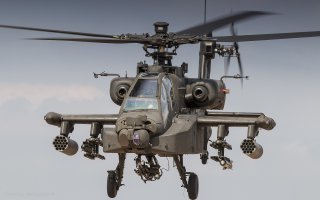Why Are U.S. Army Attack Helicopters Landing on U.S. Navy Warship?
The inter-service rivalry between the United States Army and the United States Navy is one that is typically expressed on the football field and dates back to the 1890 – but when it comes to actual military operates the services have shown that they can work quite well together.
The inter-service rivalry between the United States Army and the United States Navy is one that is typically expressed on the football field and dates back to the 1890 – but when it comes to actual military operates the services have shown that they can work quite well together.
This was reaffirmed last month when the U.S. Navy Expeditionary Landing Base ship USS Lewis B. Puller (ESB 3), which was assigned to the U.S. Naval Forces Central Command (USNAVENT), conducted joint naval and air integration operations in the Arabian Gulf with U.S. Army AH-64E Apache Guardian attack helicopters. The helicopters were assigned to U.S. Army Central Command's (USARCENT) Task Force Saber.
The operations were designed to enhance the capabilities of U.S. forces to respond to surface threats. It involved the Puller performing as a landing base platform for the Army's helicopters, whilst Cyclone-class Patrol Coastal (PC) ships were able to select simulated targets for the choppers to engage. The joint operations exercise was further supported by the U.S. Navy's guided-missile destroyer USS Paul Hamilton (DDG 60).
"The integration of U.S. Army air weapons teams with other joint fires into the maritime environment greatly enhances our ability to expand reconnaissance and attack capability," said Capt. Peter Mirisola, commander of the Destroyer Squadron (DESRON) 50, and Combined Task Force (CTF) 55. "The Apaches, in coordination with our surface ships, allow us to hold an adversary at high risk at extended ranges. Combined with other joint fires, these aircraft significantly increase the precision lethality of our joint maritime forces."
The Army's Apache AH-64E is a twin-engine, four-bladed, multi-mission attack helicopter and its origins date back to the post-Vietnam Era. It remains one of the world's premier attack helicopters, as it is designed as a highly stable aerial weapons-delivery platform that is capable of destroying an array of mobile armored targets on land or sea. It is armed with a 30mm automatic gun, aerial rockets and AGM-114 Hellfire missiles.
The Navy's Cyclone-class Patrol Coastal comprise America's naval vanguard in the Persian Gulf, and are the only U.S. warships that permanently operate off the Iranian coast.
The exercises are important for training, as the U.S. Army and U.S. Navy have conducted similar integration operations with Special Operations assets in region in the past. This included U.S. naval forces working with Army MH-6M Little Bird helicopters during Operation Earnest Will from 1987 to 1988, during the Tanker War phase of the then ongoing Iran-Iraq War.
This cooperative exercise highlighted how the Army and Navy can come together in the volatile Gulf region.
"Working with USARCENT forces represents another key capability in our ongoing integration of naval and air assets across our joint and coalition force to ensure maritime superiority," said Vice Adm. Jim Malloy, commander, USNAVCENT/U.S. 5th Fleet. "This kind of cross-domain integration allows us to maintain highly lethal and effective defensive capabilities, regardless of what platforms are operating in theater."
Peter Suciu is a Michigan-based writer who has contributed to more than four dozen magazines, newspapers and websites. He is the author of several books on military headgear including A Gallery of Military Headdress, which is available on Amazon.com.

